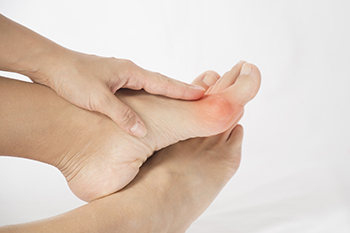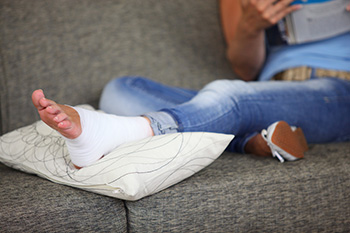Blog
Items filtered by date: June 2022
Keep Your Feet Healthy So You Can Stay Active
Bunion Surgery May Be Necessary

Bunions may be prevented from developing. A bunion is defined as a bony protrusion on the side of the big toe and can gradually occur from wearing shoes that do not fit correctly. In severe cases, the bunion can cause the other toes to overlap, and this may cause difficulty in walking and completing daily activities. Some of the suggested ways to prevent bunions from developing can include wearing shoes that have adequate room for the toes to move freely as well as avoiding high heels. It can be beneficial to frequently rest the feet as this can provide the opportunity to stretch the toes. If the bunion is painful, it may feel better to wear a protective pad on top of it which may aid in reducing the pressure against the shoe. When a bunion is severe, surgery may be a necessary option for permanent relief. If you notice the beginning stages of a developing bunion, it is suggested that you contact a podiatrist who can offer the correct treatment options.
If you are suffering from bunions, contact Queen Mbanuzue, DPM of In Step Podiatry Center. Our doctor can provide the care you need to keep you pain-free and on your feet.
What Is a Bunion?
A bunion is formed of swollen tissue or an enlargement of boney growth, usually located at the base joint of the toe that connects to the foot. The swelling occurs due to the bones in the big toe shifting inward, which impacts the other toes of the foot. This causes the area around the base of the big toe to become inflamed and painful.
Why Do Bunions Form?
Genetics – Susceptibility to bunions are often hereditary
Stress on the feet – Poorly fitted and uncomfortable footwear that places stress on feet, such as heels, can worsen existing bunions
How Are Bunions Diagnosed?
Doctors often perform two tests – blood tests and x-rays – when trying to diagnose bunions, especially in the early stages of development. Blood tests help determine if the foot pain is being caused by something else, such as arthritis, while x-rays provide a clear picture of your bone structure to your doctor.
How Are Bunions Treated?
- Refrain from wearing heels or similar shoes that cause discomfort
- Select wider shoes that can provide more comfort and reduce pain
- Anti-inflammatory and pain management drugs
- Orthotics or foot inserts
- Surgery
If you have any questions, please feel free to contact our office located in Lanham, MD . We offer the newest diagnostic and treatment technologies for all your foot care needs.
Grades of Ankle Sprains
 One of the most common types of injury that can happen to athletes and non-athletes are ankle sprains. They happen as a result of twisting, turning, or rolling the ankle beyond its normal range of motion. Some people will unexpectedly step off of a curb, and twist their ankle leading to an ankle sprain. Immediate symptoms can consist of bruising, swelling, and it is often difficult to walk. Most ankle sprains fall in one of three categories. A grade one sprain can apply to mild sprains, where there is a slight tearing of the ligaments. Walking on this type of ankle sprain is possible. A more severe sprain can be classified as a grade two sprain, and the affected ankle is tender when touched. When the ankle undergoes a complete tear, a grade three sprain has occurred. Intense pain often accompanies this type of sprain. It is advised that ankle sprains be treated immediately, regardless of the type of sprain. Please consult with a podiatrist who can properly diagnose ankle sprains, and provide you with correct treatment techniques.
One of the most common types of injury that can happen to athletes and non-athletes are ankle sprains. They happen as a result of twisting, turning, or rolling the ankle beyond its normal range of motion. Some people will unexpectedly step off of a curb, and twist their ankle leading to an ankle sprain. Immediate symptoms can consist of bruising, swelling, and it is often difficult to walk. Most ankle sprains fall in one of three categories. A grade one sprain can apply to mild sprains, where there is a slight tearing of the ligaments. Walking on this type of ankle sprain is possible. A more severe sprain can be classified as a grade two sprain, and the affected ankle is tender when touched. When the ankle undergoes a complete tear, a grade three sprain has occurred. Intense pain often accompanies this type of sprain. It is advised that ankle sprains be treated immediately, regardless of the type of sprain. Please consult with a podiatrist who can properly diagnose ankle sprains, and provide you with correct treatment techniques.
Although ankle sprains are common, they aren’t always minor injuries. If you need your ankle injury looked at, contact Queen Mbanuzue, DPM from In Step Podiatry Center. Our doctor can provide the care you need to keep you pain-free and on your feet.
How Does an Ankle Sprain Occur?
Ankle sprains are the result of a tear in the ligaments within the ankle. These injuries may happen when you make a rapid shifting movement while your foot is planted. A less common way to sprain your ankle is when your ankle rolls inward while your foot turns outward.
What Are the Symptoms?
- Pain at the sight of the tear
- Bruising/Swelling
- Ankle area is tender to touch
- In severe cases, may hear/feel something tear
- Skin discoloration
Preventing a Sprain
- Wearing appropriate shoes for the occasion
- Stretching before exercises and sports
- Knowing your limits
Treatment of a Sprain
In many cases, the RICE method (Rest, Ice, Compression, and Elevate) is used to treat ankle sprains. However, you should see a podiatrist to see which treatment option would work best with your injury. In severe cases, surgery may be required.
It is important to ask your doctor about rehab options after you receive treatment for your injury. Stretching, strength training, and balance exercises may help the ankle heal while also preventing further injury.
If you have any questions, please feel free to contact our office located in Lanham, MD . We offer the newest diagnostic and treatment technologies for all your foot care needs.
Blog Archives
- January 2025
- December 2024
- November 2024
- October 2024
- September 2024
- August 2024
- July 2024
- June 2024
- May 2024
- April 2024
- March 2024
- February 2024
- January 2024
- December 2023
- November 2023
- October 2023
- September 2023
- August 2023
- July 2023
- June 2023
- May 2023
- April 2023
- March 2023
- February 2023
- January 2023
- December 2022
- November 2022
- October 2022
- September 2022
- August 2022
- July 2022
- June 2022
- May 2022
- April 2022
- March 2022


